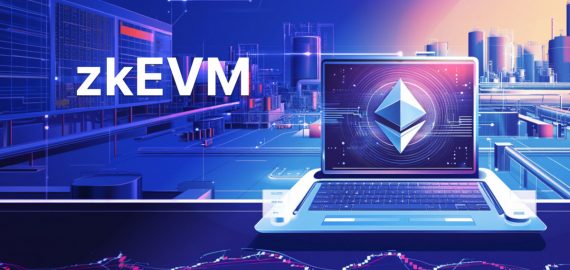Unlocking Ethereum’s Potential with Offchain Labs’ Bold Vision


In Brief
Before Ethereum existed, its scalability was already being envisioned in a Princeton classroom—an idea that shaped Steven Goldfeder’s journey from academic discovery to co-founding Offchain Labs and co-creating Arbitrum, the Layer 2 solution redefining Ethereum’s boundaries.

What if, before Ethereum even existed, the scalability of Ethereum was originally envisioned in a Princeton classroom? For Steven Goldfeder, Co-founder of Offchain Labs, that’s not just a thought experiment; it’s part of his story. His path combines academic excellence with practical effect, from an unexpected introduction to Bitcoin during a faculty discussion to co-creating Arbitrum, the Layer 2 solution that redefines Ethereum’s boundaries.
In this interview, Steven shares how Offchain Labs evolved from a research-driven idea into a powerhouse driving Ethereum’s scalability. We discuss the challenges of building secure, efficient rollups, the innovations behind Arbitrum Stylus, and how Offchain Labs continues to push the boundaries of what’s possible in Web3.
Can you share your journey to Web3?
I’ve been interested in cryptography for a long time. As an undergraduate, I did internships related to cryptography, and when I started my PhD at Princeton in 2013, I was first introduced to cryptocurrencies. My first encounter with Bitcoin was during my visit to Princeton for graduate school.
During one of the faculty talks, Professor Ed Felten gave a five-minute presentation on Bitcoin, which I had never heard of before. That was my first introduction to the concept, and interestingly, years later, Ed became my co-founder in building Arbitrum.
During my PhD, my advisor, Arvind Narayanan, was also exploring Bitcoin. Together with Ed, Arvind, and others, we wrote a textbook on Bitcoin and cryptocurrencies. My early research focused on cryptography and securing digital assets, working on multi-party computation (MPC), threshold signatures, and ECDSA, some of which were later commercialized by companies like Fireblocks.
As I approached the end of my PhD, I became particularly interested in the scalability of smart contracts, which led to Arbitrum. At that time, smart contracts were more of an academic concept—no one had really built a functioning system. However, we identified potential limitations and began working on solutions.
Interestingly, the concept of Arbitrum predates even my involvement. It started as an undergraduate seminar at Princeton, initiated by Ed Felten. If you search YouTube, you can find one of the earliest mentions of Arbitrum in a Princeton class seminar from 2014—before Ethereum even launched. We saw the limitations of smart contract technology early on and realized that if it took off, it would need scaling solutions.
Ed spent two years in the Obama administration. After returning in 2017, my co-founder Harry (who was a Princeton student at the time) and I approached him, saying, “Hey, that Arbitrum project you started a few years ago—now is the time to build it for real.” Initially, it remained an academic project, but eventually, we transitioned it into a commercial venture.
What are the primary challenges Ethereum faces in terms of scalability, and how do you see this evolving?
If you look back a few years, Ethereum’s biggest issue has always been scaling. Ethereum prioritizes fundamental decentralization and security, but it also needs scalability to be truly usable. The network must have enough throughput for people to perform their desired activities, and transaction costs must be reasonable.
Vitalik Buterin outlined the rollup-centric roadmap in 2020, which has since become Ethereum’s scaling strategy. The idea is that Ethereum remains the foundational Layer 1, securing an ecosystem of Layer 2 rollups that provide scalability. Rollups inherit Ethereum’s security while significantly increasing transaction capacity.
This also allows for diverse chains with different execution environments and experimental approaches. For example, Arbitrum is EVM-compatible but supports Rust, C, and C++ via Arbitrum Stylus. Other Layer 2s, like Starknet with Cairo and Fuel with its own VM, take different approaches. This diversity fosters innovation while still benefiting from Ethereum’s security.
One of the key challenges now is interoperability. With so many rollups and Layer 2 solutions, how do we ensure a seamless user experience where Ethereum still feels interconnected? Many teams are working on this, including Across, Layer Zero, Connext, and Espresso Systems. Coordination is key, but it should not come at the expense of the diversity that makes Ethereum special.
Are there security concerns when developing scalable solutions for Ethereum?
Security and decentralization should always be the top priorities. If the goal was just a faster system, plenty of centralized solutions would work well. But we’re building something different—an open, permissionless system that works for everyone globally.
Decentralization ensures no single entity has control, and security ensures people can trust the system. If innovation is allowed in a trustless environment, the technology must be verifiable and resilient.
At Offchain Labs, security has always been our top priority. From the first Arbitrum testnet, we ensured security proofs were in place. Others have taken different approaches, sometimes launching without full security measures, which is risky.
Vitalik proposed a three-stage roadmap for Layer 2 security and decentralization. Arbitrum was the first general-purpose rollup to reach Stage 1, and we are on track to be the first to reach Stage 2. We take security very seriously because scaling solutions that don’t prioritize security can introduce significant risks.
What do you think about current cryptographic advancements like ZK proofs? Are they too slow and expensive? Are there viable alternatives?
Arbitrum currently operates as an optimistic rollup, relying on fraud proofs. It is the most mature Ethereum scaling stack, with the most diverse feature set, including full EVM compatibility and Arbitrum Stylus.
Our philosophy has always been goal-driven rather than tool-driven. Some teams start with a particular tool—like zero-knowledge proofs—and then try to fit a solution around it. We take the opposite approach: focusing on the goal first and then selecting the best tools to achieve it.
I’ve been researching zero-knowledge proofs for years, long before Arbitrum existed. Early on, it was clear that ZK technology wasn’t mature enough for scalable blockchains. Even today, it remains significantly more costly than optimistic rollups and is not yet fully compatible with Ethereum. However, space is evolving rapidly.
We have a strong research team, including cryptographers like Victor Shoup and Rosario Gennaro, who constantly evaluate how and when zero-knowledge technology could be incorporated into Arbitrum. While we’re getting closer, we still believe that today, the most secure and cost-effective solution remains optimistic rollups.
That said, when the time comes, we’ll adapt. In 2022, we transitioned from our original Arbitrum Virtual Machine (AVM) to Nitro, which was significantly more efficient. If a better approach emerges—whether through ZK or another innovation—we’ll be ready to integrate it.
How will sharding impact Ethereum’s transaction throughput and network performance?
Sharding has different meanings in different contexts. While Ethereum initially planned execution sharding, the rollup-centric roadmap has largely taken over. Rollups already function like a form of sharding, distributing computation across multiple Layer 2 chains.
On the data side, Ethereum introduced EIP-4844, which brought blob data to the network, significantly improving rollup efficiency. Our team at Offchain Labs contributed to this effort through Prysm, an Ethereum Layer 1 client.
Future improvements, like increased blob capacity and enhanced data availability, will improve scalability. However, I believe rollups will remain the dominant way users interact with Ethereum.
What emerging technologies do you think will have the biggest impact on scalability?
There are a few things. Number one, we’re constantly improving systems. Right now, the Arbitrum DAO has a vote happening where Bold is expected to go live on Arbitrum. BOLD is a new optimistic rollup protocol that’s much more efficient and makes it easier for more users to participate. So, massive innovation is happening in optimistic rollups and their technology.
I think we’ll continue to see innovation in different types of improving systems that make the current system better and allow us to do more. For example, Arbitrum Stylus is a great example. I mentioned it before—it allows you to write smart contracts in Rust, C, and C++, but I didn’t mention that it’s not just a UX feature or a developer experience feature. It also gives about a 10x performance improvement.
So, it turns out that using Arbitrum Stylus and writing contracts in arbitrary languages is about one order of magnitude, or 10 times, more efficient because of how these technologies work. That means for the same validation cost or the same workload among validators, you can get about 10 times more in. That’s important when looking for ways to increase throughput.
Then, of course, zero-knowledge proofs. We talked about ZK before, and there’s a massive advancement happening there. There are ways to improve both the Layer 1 experience and the Layer 2 experience by leveraging ZK. But I think the key here is not to rush into things just for the sake of using ZK but rather to ask: how can we use ZK to achieve our goal? Our goal is to make Ethereum more scalable and more efficient. Over time, there will be opportunities to introduce ZK in different parts of the protocol to help with that, and we’re starting to see that happen.
The last piece is just generally better nodes, better node support, and continued innovation in that space. We see so many different teams working on this—of course, the Geth team is fantastic, but there are also teams like Erigon and Nethermind teams, all working to make Ethereum nodes more performant.
So, all these things—improving the core node software, using technology like zero-knowledge proofs, and out-of-the-box innovations like Stylus—will improve execution. Ultimately, we’ll need all the help we can get, right? It’s not just one tool that will solve everything. Demand is constantly increasing, so we’ll need a combination of these innovations to stay ahead.
Can you share Offchain Labs’ roadmap for this year and beyond?
So, fundamentally, we are a service provider. We do a few things.
Number one, we’re a service provider to the Arbitrum Foundation and DAO, and we constantly look for ways to ensure the technology stays relevant, important, and innovative. We always ask, “How do we improve Arbitrum?” because while Arbitrum is unquestionably the most mature Ethereum scaling solution today, we are always learning internally and as an ecosystem.
I mentioned before that our research team is doing deep work in zero-knowledge technology, asking how and when it would make sense to introduce it into the Arbitrum stack. But beyond that, we’re focused on improving the core Arbitrum One experience and the entire ecosystem of Arbitrum chains. Arbitrum Orbit, for example, is growing rapidly—beyond Arbitrum One, there are over a hundred chains in development using Arbitrum technology in different ways. One of them, Fhenix, is building a fully homomorphic encryption privacy chain on Ethereum using the Arbitrum tech stack.
We are also improving the core technology itself. BOLD, the new optimistic rollup protocol, is launching on Arbitrum chains, which we’ve been working on for years. Another project is Timeboost, an innovation in sequencing technology that will soon be up for a vote in the Arbitrum DAO, focused on internalizing MEV for Arbitrum chains.
Then there’s our work on Ethereum Layer 1. We built Prysm, one of the leading Ethereum execution clients. Our goal here is to ensure Ethereum remains the best Layer 1 environment, which I believe it is today, but we can’t take that for granted. We need to improve its support for rollups, make rollup-to-rollup communication faster, increase data availability, and ensure rollups stay cost-effective. We’re also working on improving censorship resistance in Ethereum’s Layer 1.
Beyond our direct contributions, we have Tandem, our investment and incubation arm. Through Tandem, we work with other teams to scale the ecosystem beyond ourselves. We have deep resources in research, engineering, partnerships, and products, and we use those resources to help teams grow much faster than they could on their own. We want to ignite the ecosystem by giving startups access to expertise they wouldn’t normally have—especially in research, which is something most early-stage projects can’t focus on.
You’ll also see Offchain Labs launch new products. I can’t share too many details right now, but we’re working on tools that will improve UX and make the ecosystem more interconnected. As we partner with others, we always ask: What affordances can we introduce? What tools can we build to help create a more seamless and integrated ecosystem?
Ultimately, we see ourselves as team players in this space. Whether through partnerships, new launches, or supporting the Arbitrum and Ethereum communities, our focus is always on improving the experience for developers and users.
Disclaimer
In line with the Trust Project guidelines, please note that the information provided on this page is not intended to be and should not be interpreted as legal, tax, investment, financial, or any other form of advice. It is important to only invest what you can afford to lose and to seek independent financial advice if you have any doubts. For further information, we suggest referring to the terms and conditions as well as the help and support pages provided by the issuer or advertiser. MetaversePost is committed to accurate, unbiased reporting, but market conditions are subject to change without notice.
About The Author
Victoria is a writer on a variety of technology topics including Web3.0, AI and cryptocurrencies. Her extensive experience allows her to write insightful articles for the wider audience.
More articles

Victoria is a writer on a variety of technology topics including Web3.0, AI and cryptocurrencies. Her extensive experience allows her to write insightful articles for the wider audience.

















































